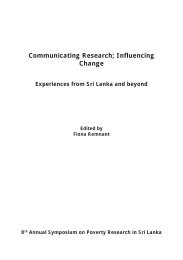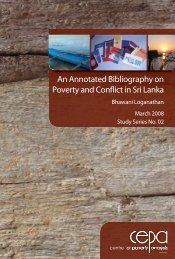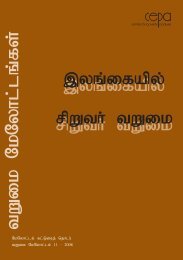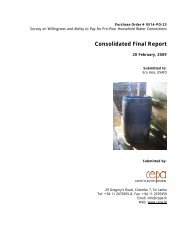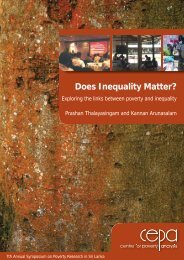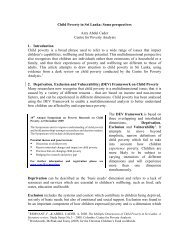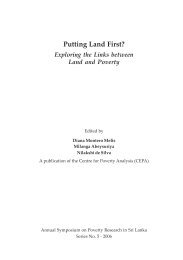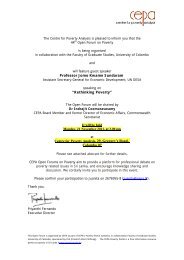Involuntary Displacement and Resettlement â Policy and ... - CEPA
Involuntary Displacement and Resettlement â Policy and ... - CEPA
Involuntary Displacement and Resettlement â Policy and ... - CEPA
- No tags were found...
You also want an ePaper? Increase the reach of your titles
YUMPU automatically turns print PDFs into web optimized ePapers that Google loves.
hetoric of displacement <strong>and</strong> maintain the groups’ wish to return to theiroriginal homel<strong>and</strong>s as a justification for their continued vulnerability.Over time attitudes among the host community towards the IDPs changedfrom one of welcome <strong>and</strong> support, immediately after their arrival, to directcompetition for livelihood support, development benefits <strong>and</strong> services(highlighted by Brun in her chapter in this volume). This competition has ledto incidents of conflict <strong>and</strong> a growing resentment between the IDPs <strong>and</strong>some groups in the host community. The prevailing atmosphere ofcompetition <strong>and</strong> conflict has led many within the district to contest thecontinued recognition by the state <strong>and</strong> development institutions of the IDPsas a vulnerable population group. The debate about their status vis a visother groups in the district continues.The Making Peace − Keeping Peace study examines conflict <strong>and</strong> resolution inPuttalam, within the wider backdrop of these assertions, competitions <strong>and</strong>challenges. This paper draws from the study results specific aspects of IDPhost relations <strong>and</strong> their role in creating <strong>and</strong> maintaining conflict.1.1 Puttalam − History of In-migrationThe Puttalam district has a long history of in-migration. Despite waves ofin-migration during ancient times, migration due to trade during the colonialera, <strong>and</strong> post independence migration as a result of irrigation settlementschemes, it is the arrival of the IDPs in 1990 that continues to have the mostimpact on Puttalam.In October 1990, the LTTE expelled almost 100,000 Muslims from Mannar,Jaffna <strong>and</strong> other districts in the North <strong>and</strong> East that were under their control.Many of those displaced in that time came to Puttalam. The IDPs werelargely from Mannar (74%), <strong>and</strong> almost exclusively Muslim (99%) (UNHCR,2006). They have remained in the district since their initial expulsion. Somereturned for a short time during the ceasefire period between 2002 <strong>and</strong> 2006but went back to Puttalam when fighting resumed.It is their long term displacement that sets IDPs in Puttalam apart from otherdisplaced persons in Sri Lanka. While they were welcomed initially by thehost community, this relationship deteriorated over time into competition <strong>and</strong>conflict.113



